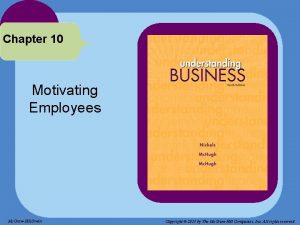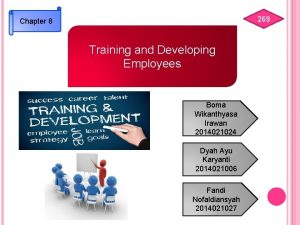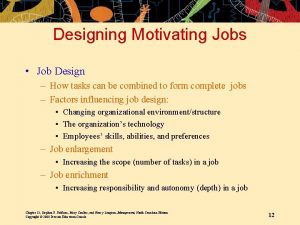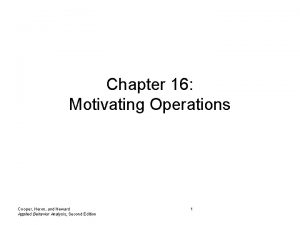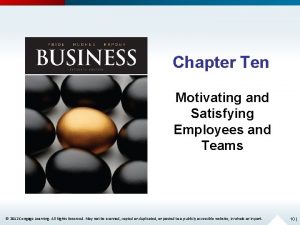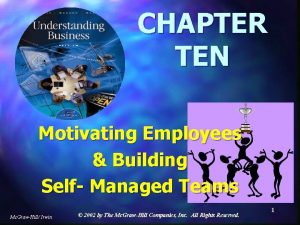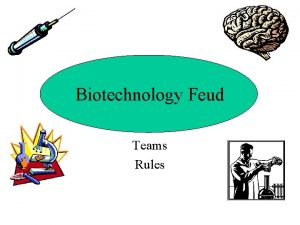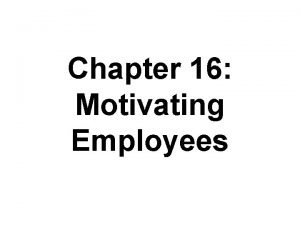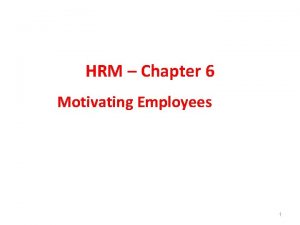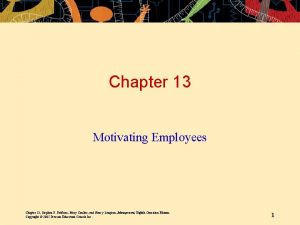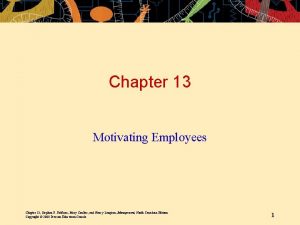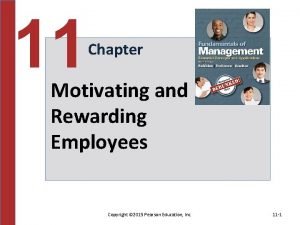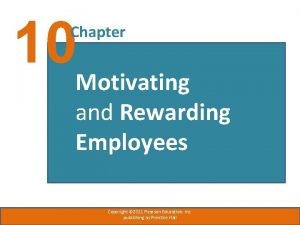Motivating Employees and Creating SelfManaged Teams Chapter 10




















- Slides: 20

Motivating Employees and Creating Self-Managed Teams Chapter 10

Chapter Overview 1. Evolution of Motivation Theory 2. Contemporary Views on Motivation 3. Applying Motivation Theory 4. Using Teams to Motivate 5. Trends in Motivating Employees

Evolution of Motivation Theory 1. Scientific Management 2. Hawthorne Studies 3. Hierarchy of Needs 4. Theories X and Y 5. Motivator-Hygiene Theory

Principles of Scientific Management 1. Develop a science of every job element 2. Scientifically select, train, & instruct workers 3. Cooperation between workers & managers 4. Match individuals to well-suited tasks and responsibilities

Hawthorne Studies Hawthorne Effect: The phenomenon that employees perform better when they feel singled out for attention or feel that management is concerned about their welfare

Maslow’s Hierarchy of Needs Selfactualization needs Esteem needs Social needs Safety needs Physiological needs

Mc. Gregor’s Theories of Human Motivation Theory X Theory Y people dislike work is as natural as play people need to be controlled, & threatened people avoid responsibility & value security people respond to positive incentives people enjoy responsibility & like to solve problems

Herzberg’s Motivator-Hygiene Theory Motivating factors: intrinsic job elements that lead to worker satisfaction Hygiene factors: extrinsic elements of the work environment that, if not managed well, lead to worker dissatisfaction

Contemporary Motivation Theory 1. Expectancy Theory 2. Equity Theory 3. Goal-Setting Theory

Expectancy theory: The probability of a behavior depends on: (1) strength of individual’s belief that the behavior will have a particular outcome, and (2) whether the individual values the outcome

Equity theory: Worker satisfaction is influenced by employees’ perceptions about how fairly they are treated compared with their coworkers

Equity Theory Upward social comparison: comparing oneself to another who is better off on a particular attribute ® frequently results in decreased satisfaction Downward social comparison: comparing oneself to another who is worse off on a particular attribute ® frequently results in increased satisfaction

Applying Motivation Theory 1. Motivational job design – job enlargement – job enrichment – job rotation 2. Work scheduling options – job sharing 3. Recognition, empowerment, & economic incentives – variable pay

Job Characteristics Model 1. Skill variety 2. Task identity – task has visible results 3. Task significance 4. Autonomy – employee freedom and independence 5. Task feedback – working on task provides performance feedback Source: Hackman & Oldham, 1976, Organizational Behavior and Human Performance, v. 16, pp. 250 -279.

Group cohesiveness: the degree to which group members want to stay in the group and tend to resist outside influences

2 Types of Cohesiveness 1. Interpersonal cohesiveness: strong bonds & liking between people 2. Task cohesiveness: strong commitment to the group task among members Cohesiveness can increase team performance, but interpersonally cohesive teams may lack task focus Source: Kenrick et al. , Social Psychology, p. 441.

Pros and Cons of Teams Pros: Cons: • more information & knowledge • can generate more alternatives • often higher-quality decisions • group participation increases acceptance of solutions • take longer to reach solution • members may suppress disagreement • group may be dominated by a few individuals • lack of accountability

Types of Teams 1. Problem-solving within one area within one management level 2. Cross-functional within one management level across different areas 3. Self-managed autonomous

Building Blocks of High Performance Teams 1. Skills 2. Accountability 3. Commitment • • • Problem solving Technical/functional Interpersonal Small number of members Mutual accountability Individual accountability • Specific goals • Common approach • Meaningful purpose

Trends in Motivation Improved Education & Training Increased Employee Ownership More Work-Life Benefits ·Deloitte & Touche consulting firm offers Work/life Balance options: reduced hours, reduced workload, continuing part-time, flextime, telecommuting, assistance programs (Source: Deloitte & Touche, www. dttus. com)
 Motivating and satisfying employees and teams
Motivating and satisfying employees and teams Chapter 10 motivating and satisfying employees and teams
Chapter 10 motivating and satisfying employees and teams Motivating and satisfying employees and teams
Motivating and satisfying employees and teams Motivating and satisfying employees and teams
Motivating and satisfying employees and teams Copyright
Copyright Chapter 10 motivating employees
Chapter 10 motivating employees Chapter 10 motivating employees
Chapter 10 motivating employees Chapter 10 motivating employees
Chapter 10 motivating employees Herzberg’s two-factor theory
Herzberg’s two-factor theory Motivating employees without money
Motivating employees without money Creating extraordinary teams
Creating extraordinary teams Motivating yourself and others
Motivating yourself and others Leading and motivating a team
Leading and motivating a team Chapter 8 training and developing employees
Chapter 8 training and developing employees Chapter 8 training and development
Chapter 8 training and development Chapter 9 attracting and retaining the best employees
Chapter 9 attracting and retaining the best employees Motivating parallelism
Motivating parallelism How to motivate esl students
How to motivate esl students Designing motivating jobs
Designing motivating jobs Cmo-t examples
Cmo-t examples Reinforcement indicator examples
Reinforcement indicator examples






